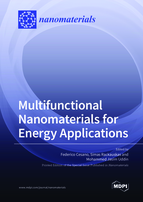Multifunctional Nanomaterials for Energy Applications
A special issue of Nanomaterials (ISSN 2079-4991). This special issue belongs to the section "Energy and Catalysis".
Deadline for manuscript submissions: closed (31 December 2021) | Viewed by 45999
Special Issue Editors
Interests: composite/hybrid materials and nanomaterials; surface Science; microscopies and spectroscopies; catalysis and photocatalysis
Special Issues, Collections and Topics in MDPI journals
Interests: 1D nanomaterial synthesis; 1D growth mechanism investigation; ZnO nanowires for chemosensors
Special Issues, Collections and Topics in MDPI journals
Interests: green energy; nanotechnology; surface science; photocatalysis; catalysis
Special Issues, Collections and Topics in MDPI journals
Special Issue Information
Dear colleagues,
In the last few decades, global energy requirements have grown exponentially, and increased demand is expected in the upcoming decades. Traditional energy resources have remarkably impacted energy production so far, but the use of renewable energy sources has constantly increased and is gradually substituting fossil fuels. Such non-renewable energy resources are limited in nature, and their use for energy purposes affects climate change. The new paradigm is materials for sustainable energy, and when materials are nanostructured, new key concepts are involved. Nanomaterials exhibit properties very different from their bulk counterparts due to their significant surface boundary and quantum confinement characteristics. Furthermore, the structure (or nanophase assembly) is also relevant to explain various novel and interesting properties, notably when energy applications are taken into consideration. Remarkably, the aggregation and interface properties of nanostructures, even at lower dimensionality, are expected to boost energy applications.
Among all materials, polymers and polymer-based composites have emerged as potential energy conversion and storage materials thanks to their blend of stability, flexibility, workability, resistance to corrosion, and electrical properties (either alone or combined with conductive filler). Supercapacitors and electrochemical capacitors are two examples of efficient energy storage because they have a very high current density and use low-cost polymer-based materials, as compared to other electrode materials. Among all materials, inorganic structures, as well as their combinations and composites, have achieved record values in harvesting efficiency of solar and thermal energies and for electrode materials.
This Special Issue aims to highlight the latest energy advances in the field of materials, in particular low-dimensional materials. Various topics related to synthesis and characterization methods, properties, and energy application uses are covered.
Prof. Dr. Federico Cesano
Dr. Simas Rackauskas
Dr. Mohammed Jasim Uddin
Guest Editors
Manuscript Submission Information
Manuscripts should be submitted online at www.mdpi.com by registering and logging in to this website. Once you are registered, click here to go to the submission form. Manuscripts can be submitted until the deadline. All submissions that pass pre-check are peer-reviewed. Accepted papers will be published continuously in the journal (as soon as accepted) and will be listed together on the special issue website. Research articles, review articles as well as short communications are invited. For planned papers, a title and short abstract (about 100 words) can be sent to the Editorial Office for announcement on this website.
Submitted manuscripts should not have been published previously, nor be under consideration for publication elsewhere (except conference proceedings papers). All manuscripts are thoroughly refereed through a single-blind peer-review process. A guide for authors and other relevant information for submission of manuscripts is available on the Instructions for Authors page. Nanomaterials is an international peer-reviewed open access semimonthly journal published by MDPI.
Please visit the Instructions for Authors page before submitting a manuscript. The Article Processing Charge (APC) for publication in this open access journal is 2900 CHF (Swiss Francs). Submitted papers should be well formatted and use good English. Authors may use MDPI's English editing service prior to publication or during author revisions.
Keywords
- batteries
- electrode materials
- energy-harvesting materials
- energy-saving materials
- fuel production and storage
- low-dimensionality materials
- nanomaterials
- piezoelectric materials
- smart materials
- solar energy harvesting
- supercapacitors
- thermal energy storage
- thermoelectric materials
- triboelectric materials








